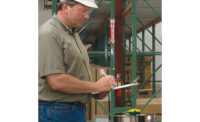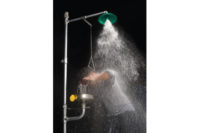
Much is said and written about the best ways to respond to in-plant emergency situations involving acid or base spill/splash or blown particulate incidents. The truth is safety equipment manufacturers often times serve selfish interests in slanting “best practice” advice toward their specific designs or technologies. Specifiers should consider advice given with careful assessment of their own circumstances and the validity of the advice, after objective evaluation of products, and response approaches versus other alternatives.
The undeniable facts:
- Per the National Safety Council’s 2007
Injury Facts®, losses from unintentional worker
injuries cost the U.S. economy more than $650
billion dollars in 2006. Wage and productivity
losses accounted for a whopping $330 billion
of the total. And that doesn’t include potential
long-term disabilities, litigation costs and other
losses associated with downstream liabilities.
- On-the-job injuries are a huge problem that, put into perspective, is equivalent to 62 percent of the total revenue the government collects in personal income taxes each year or 52 percent of the total cost of feeding the entire population of the United States.
Risk-rating the selection of emergency equipment
So where do you start in assembling a list of appropriate emergency equipment? A growing trend is emerging with respect to a risk-rated response approach. That is, you begin by determining the sources, materials and severity of the injury risk in your plant or section thereof. If you are considering the needs of a wood shop, for example, blown particulate might be the hazardous material and the source could be power woodworking equipment or simply the ventilation system or an open door. ANSI states that the first response equipment, in this case an eyewash, should be located within an unobstructed ten-second walk from the hazard site. That’s obviously a simple example, but you get the point. What’s your risk, both source and material? Once you know that, it’s relatively easy to match the proper emergency equipment to the need and also pretty much determine the most suitable location.
Emergency equipment selection
This part is, perhaps, not quite as simple as one might expect. There are myriad variations and alternatives of drench showers and eyewashes on the market. Many operate essentially the same, mostly due to the simplistic nature of the needed functions: showering a diffused stream of water down on an injured victim or spraying streams of water upward, forming a double arch of water for eye irrigation. Once you’ve decided on the type of equipment needed — eyewash, eye and face wash, drench shower or combination eyewash/drench shower — then the tricky part comes into play.
In specific brand and model selection, the best of the available alternatives are differentiated from the others by the features they include and, ultimately, how important those features are to you. Some of the ideal features are categorized below:
Drench showers
Beyond ANSI compliance (which is an assumed requirement for all emergency equipment), drench shower specifiers should look for flow controls. Flow controls work to maintain a consistent flow rate over the entire use cycle to which the shower will be subjected. Without flow controls, fluctuations in line pressure and other upstream factors could result in flows that are less than the required 20 gallons per minute (gpm) or even substantially above the threshold limit. These much higher flow rates could pose a challenge, in terms of being able to stay under the shower for the ANSI required 15 minutes.
Other feature and design considerations for drench showers include available wheelchair accessible designs (to meet the needs of people who fall under the Americans With Disabilities Act), as well as actuation handle designs that may be more or less appropriate for your specific application needs. And don’t forget to consider the materials used in construction, as use in a corrosive environment can dramatically lower any product’s lifespan!
A recent design innovation from several manufacturers involves the use of spray nozzles instead of traditional shower head designs. Spray nozzle technologies have advanced to the point where the best designs spin and, in a manner of speaking, break up the water so it can be distributed in a much more even flow pattern throughout its entire footprint. These designs provide superior coverage and drenching capability versus the traditional shower head, where the water is generally forced to the outer perimeter of the shower outlet “bell” leaving the inner portions of the footprint with substantially less total water coverage.
Eyewashes
Similar to drench showers, eyewashes are also sometimes differentiated by the use of flow controls, the lack of which can result in some products making an amazing 18-inch tall jet of water. While this spout may be impressive looking, it’s certainly not an appealing place to stick your face. Additionally, eyewashes and eye/face washes can be either ADA wheelchair compliant or not, as well as having differing actuation controls and construction materials. Once again, construction materials are an important consideration in corrosive environments, heavy sunlight locations, etc.
Until recently, the specific features of eyewash products have remained relatively unchanged for the 60+ years of their existence. Recent advancements in linking eyewash designs to the eye irrigation protocols used by medical professionals have resulted in medically superior products. These products feature flow patterns that contact the eyes at the inner corner and flow outward toward the outer corner of each eye. This design allows the irrigation fluid to sweep contaminants away from the lacrimal punctum (or the ocular surface’s drains). The lacrimal punctum drain excess fluid from the surface of the eye directly into the nasal cavity. Using old style eyewash products, contaminants in the eyes that are introduced to the lacrimal punctum could easily be pushed into the nasal cavity, to be swallowed or inhaled.
As we’ve seen, not all drench shower and eyewash products are created equally. Some are differentiated, with features that may make the most sense for your application.

